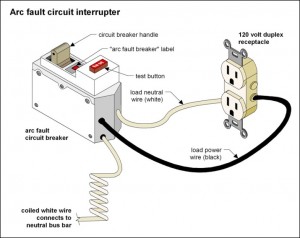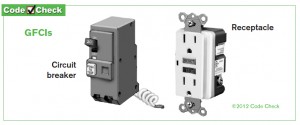Not if you want to stay healthy!
Both units, although very different in function, look alike in the electrical panel. They look like conventional circuit breakers with a test button on their face and they both attach to the panel in a normal circuit breaker slot and are bonded to the neutral bus bar with a, rear mounted, tightly coiled white wire.
 The AFCI, Arc Fault Circuit Interrupter, was introduced to residential electrical codes in 1999 with the requirement to install them in bedrooms and has quickly gained acceptance, particularly with Fire Marshalls, because the device reliably opens damaged circuits that are overheating because of arcing (mini fires). Recent editions of the electrical codes have included installation in most living areas. Unfortunately, there are other over-heating issues with circuits that cannot be detected by the AFCI, such as an electric motor starting or someone pulling a cord out of a live outlet or wires overheating through high current demand meeting high resistance without any arcing occurring.
The AFCI, Arc Fault Circuit Interrupter, was introduced to residential electrical codes in 1999 with the requirement to install them in bedrooms and has quickly gained acceptance, particularly with Fire Marshalls, because the device reliably opens damaged circuits that are overheating because of arcing (mini fires). Recent editions of the electrical codes have included installation in most living areas. Unfortunately, there are other over-heating issues with circuits that cannot be detected by the AFCI, such as an electric motor starting or someone pulling a cord out of a live outlet or wires overheating through high current demand meeting high resistance without any arcing occurring.
When must I install these devices?
Never! Installing these critical devices is a job for a licensed electrician. They can advise you as to the necessity for installation of these devices and proper wiring technique. Except for a room addition or replacement of an existing failed device, AFCI’s are usually only installed in new wiring systems.
Where does today’s code require these devices to be installed?
AFCI’s are installed in all bedrooms and living areas, but not unfinished basements and garages. GFCI’s are installed in all potentially wet areas, including kitchens, bathrooms, basements, and exterior outlets. Some circuits can even require the installation of both an AFCI and a GFCI.
Doug Hastings
MN Home Inspector, Minneapolis & St. Paul
ASHI certified inspector, ACI
Kaplan University, Home Inspection Lead Instructor
Rob ‘Pops’ Leslie
Kaplan Professionals, Retired




